Peter vs. Wollongong Council: Negligent Misstatement Case Analysis
VerifiedAdded on 2021/06/14
|6
|1552
|129
Case Study
AI Summary
This case study analyzes a legal issue concerning a real estate developer, Peter, who is seeking to sue the Wollongong Council for economic loss resulting from a negligent misrepresentation. The core issue revolves around whether the council can be held liable for providing a certificate that negligently omitted a road widening proposal, thereby impacting the value of Peter's land. The analysis examines the principles of negligent misstatement, duty of care, and the elements of tort law, including fault, actual damage, and remedy. It references key legal precedents such as Shaddock v Parramatta City Council and Mutual Life v Evatt. The study applies these legal principles to the facts, considering Peter's awareness of the certificate's negligence and his failure to rely on it. It also explores defenses like contributory negligence and voluntary assumption of risk, concluding that Peter cannot successfully sue the council due to his lack of reliance on the misstatement and his pre-existing knowledge of the error. The case study underscores the importance of reliance and the limitations of liability in negligent misstatement cases.
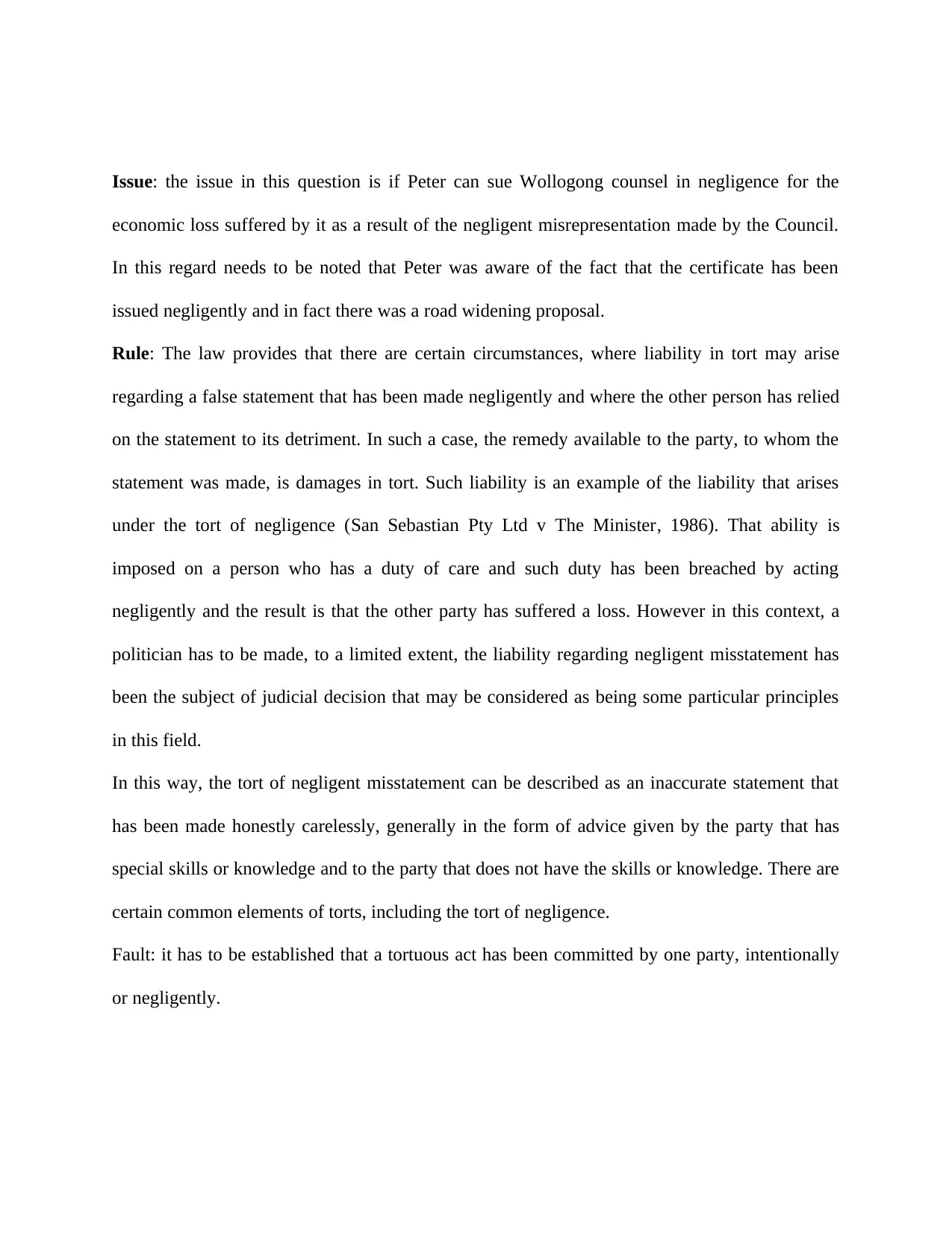
Issue: the issue in this question is if Peter can sue Wollogong counsel in negligence for the
economic loss suffered by it as a result of the negligent misrepresentation made by the Council.
In this regard needs to be noted that Peter was aware of the fact that the certificate has been
issued negligently and in fact there was a road widening proposal.
Rule: The law provides that there are certain circumstances, where liability in tort may arise
regarding a false statement that has been made negligently and where the other person has relied
on the statement to its detriment. In such a case, the remedy available to the party, to whom the
statement was made, is damages in tort. Such liability is an example of the liability that arises
under the tort of negligence (San Sebastian Pty Ltd v The Minister, 1986). That ability is
imposed on a person who has a duty of care and such duty has been breached by acting
negligently and the result is that the other party has suffered a loss. However in this context, a
politician has to be made, to a limited extent, the liability regarding negligent misstatement has
been the subject of judicial decision that may be considered as being some particular principles
in this field.
In this way, the tort of negligent misstatement can be described as an inaccurate statement that
has been made honestly carelessly, generally in the form of advice given by the party that has
special skills or knowledge and to the party that does not have the skills or knowledge. There are
certain common elements of torts, including the tort of negligence.
Fault: it has to be established that a tortuous act has been committed by one party, intentionally
or negligently.
economic loss suffered by it as a result of the negligent misrepresentation made by the Council.
In this regard needs to be noted that Peter was aware of the fact that the certificate has been
issued negligently and in fact there was a road widening proposal.
Rule: The law provides that there are certain circumstances, where liability in tort may arise
regarding a false statement that has been made negligently and where the other person has relied
on the statement to its detriment. In such a case, the remedy available to the party, to whom the
statement was made, is damages in tort. Such liability is an example of the liability that arises
under the tort of negligence (San Sebastian Pty Ltd v The Minister, 1986). That ability is
imposed on a person who has a duty of care and such duty has been breached by acting
negligently and the result is that the other party has suffered a loss. However in this context, a
politician has to be made, to a limited extent, the liability regarding negligent misstatement has
been the subject of judicial decision that may be considered as being some particular principles
in this field.
In this way, the tort of negligent misstatement can be described as an inaccurate statement that
has been made honestly carelessly, generally in the form of advice given by the party that has
special skills or knowledge and to the party that does not have the skills or knowledge. There are
certain common elements of torts, including the tort of negligence.
Fault: it has to be established that a tortuous act has been committed by one party, intentionally
or negligently.
Paraphrase This Document
Need a fresh take? Get an instant paraphrase of this document with our AI Paraphraser
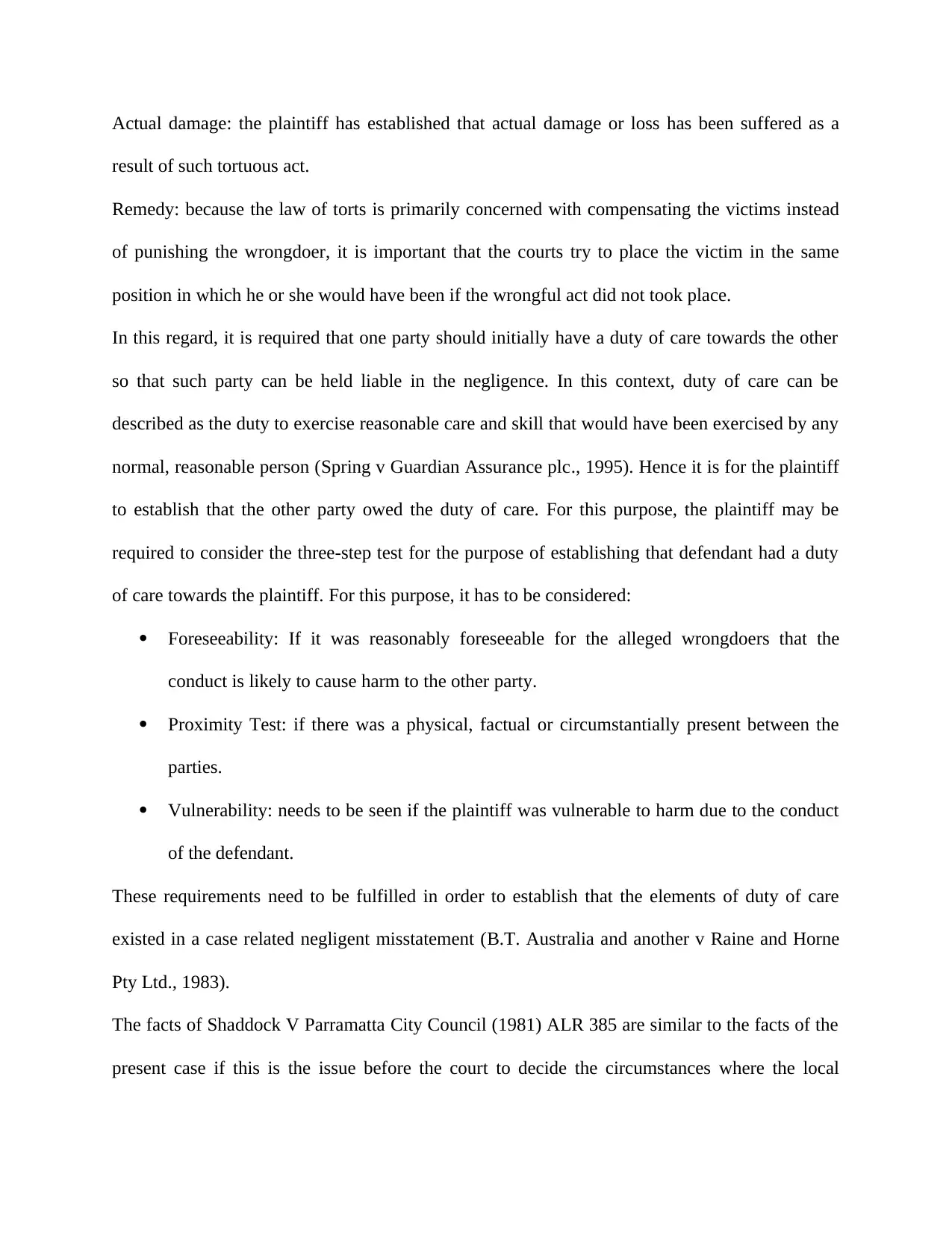
Actual damage: the plaintiff has established that actual damage or loss has been suffered as a
result of such tortuous act.
Remedy: because the law of torts is primarily concerned with compensating the victims instead
of punishing the wrongdoer, it is important that the courts try to place the victim in the same
position in which he or she would have been if the wrongful act did not took place.
In this regard, it is required that one party should initially have a duty of care towards the other
so that such party can be held liable in the negligence. In this context, duty of care can be
described as the duty to exercise reasonable care and skill that would have been exercised by any
normal, reasonable person (Spring v Guardian Assurance plc., 1995). Hence it is for the plaintiff
to establish that the other party owed the duty of care. For this purpose, the plaintiff may be
required to consider the three-step test for the purpose of establishing that defendant had a duty
of care towards the plaintiff. For this purpose, it has to be considered:
Foreseeability: If it was reasonably foreseeable for the alleged wrongdoers that the
conduct is likely to cause harm to the other party.
Proximity Test: if there was a physical, factual or circumstantially present between the
parties.
Vulnerability: needs to be seen if the plaintiff was vulnerable to harm due to the conduct
of the defendant.
These requirements need to be fulfilled in order to establish that the elements of duty of care
existed in a case related negligent misstatement (B.T. Australia and another v Raine and Horne
Pty Ltd., 1983).
The facts of Shaddock V Parramatta City Council (1981) ALR 385 are similar to the facts of the
present case if this is the issue before the court to decide the circumstances where the local
result of such tortuous act.
Remedy: because the law of torts is primarily concerned with compensating the victims instead
of punishing the wrongdoer, it is important that the courts try to place the victim in the same
position in which he or she would have been if the wrongful act did not took place.
In this regard, it is required that one party should initially have a duty of care towards the other
so that such party can be held liable in the negligence. In this context, duty of care can be
described as the duty to exercise reasonable care and skill that would have been exercised by any
normal, reasonable person (Spring v Guardian Assurance plc., 1995). Hence it is for the plaintiff
to establish that the other party owed the duty of care. For this purpose, the plaintiff may be
required to consider the three-step test for the purpose of establishing that defendant had a duty
of care towards the plaintiff. For this purpose, it has to be considered:
Foreseeability: If it was reasonably foreseeable for the alleged wrongdoers that the
conduct is likely to cause harm to the other party.
Proximity Test: if there was a physical, factual or circumstantially present between the
parties.
Vulnerability: needs to be seen if the plaintiff was vulnerable to harm due to the conduct
of the defendant.
These requirements need to be fulfilled in order to establish that the elements of duty of care
existed in a case related negligent misstatement (B.T. Australia and another v Raine and Horne
Pty Ltd., 1983).
The facts of Shaddock V Parramatta City Council (1981) ALR 385 are similar to the facts of the
present case if this is the issue before the court to decide the circumstances where the local
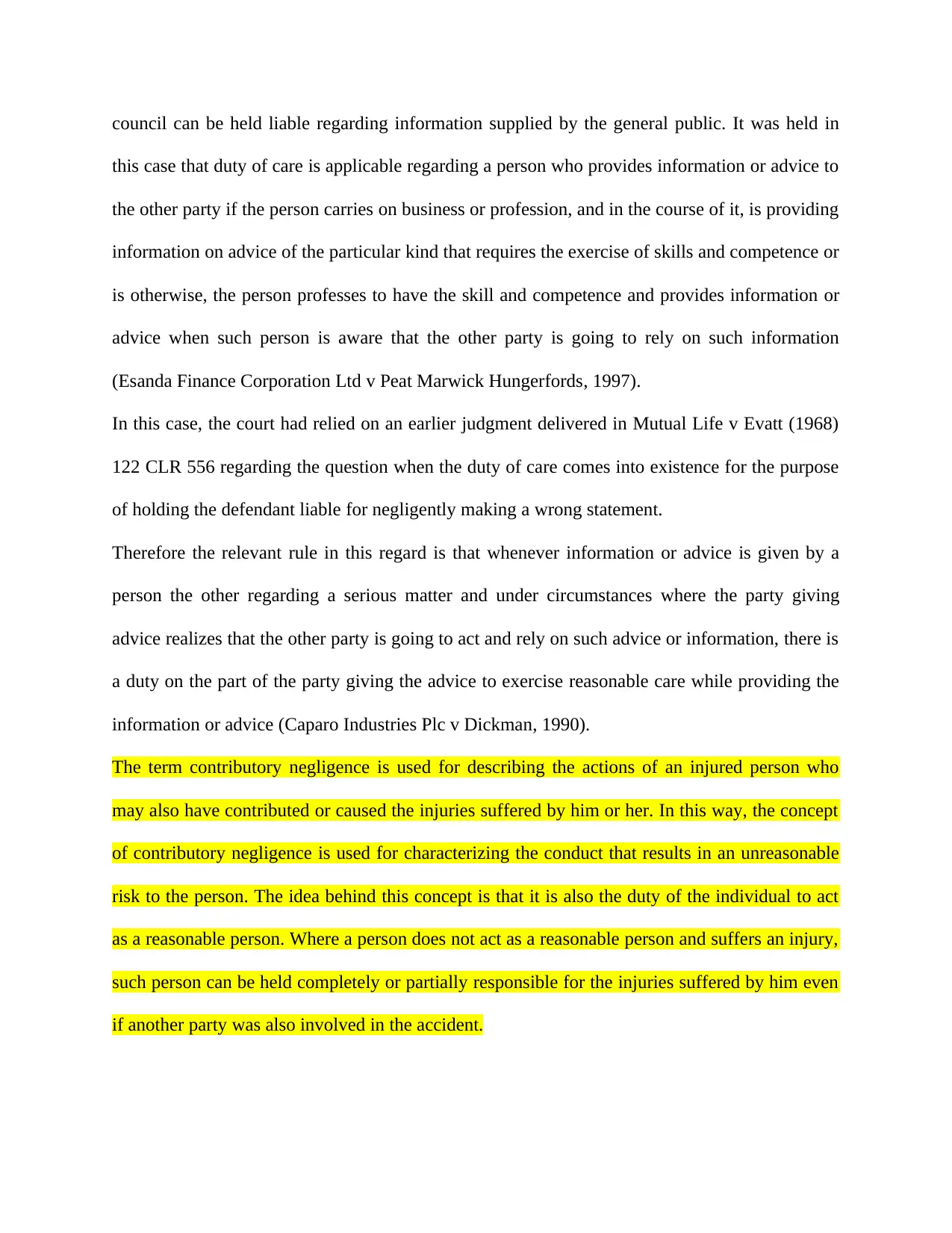
council can be held liable regarding information supplied by the general public. It was held in
this case that duty of care is applicable regarding a person who provides information or advice to
the other party if the person carries on business or profession, and in the course of it, is providing
information on advice of the particular kind that requires the exercise of skills and competence or
is otherwise, the person professes to have the skill and competence and provides information or
advice when such person is aware that the other party is going to rely on such information
(Esanda Finance Corporation Ltd v Peat Marwick Hungerfords, 1997).
In this case, the court had relied on an earlier judgment delivered in Mutual Life v Evatt (1968)
122 CLR 556 regarding the question when the duty of care comes into existence for the purpose
of holding the defendant liable for negligently making a wrong statement.
Therefore the relevant rule in this regard is that whenever information or advice is given by a
person the other regarding a serious matter and under circumstances where the party giving
advice realizes that the other party is going to act and rely on such advice or information, there is
a duty on the part of the party giving the advice to exercise reasonable care while providing the
information or advice (Caparo Industries Plc v Dickman, 1990).
The term contributory negligence is used for describing the actions of an injured person who
may also have contributed or caused the injuries suffered by him or her. In this way, the concept
of contributory negligence is used for characterizing the conduct that results in an unreasonable
risk to the person. The idea behind this concept is that it is also the duty of the individual to act
as a reasonable person. Where a person does not act as a reasonable person and suffers an injury,
such person can be held completely or partially responsible for the injuries suffered by him even
if another party was also involved in the accident.
this case that duty of care is applicable regarding a person who provides information or advice to
the other party if the person carries on business or profession, and in the course of it, is providing
information on advice of the particular kind that requires the exercise of skills and competence or
is otherwise, the person professes to have the skill and competence and provides information or
advice when such person is aware that the other party is going to rely on such information
(Esanda Finance Corporation Ltd v Peat Marwick Hungerfords, 1997).
In this case, the court had relied on an earlier judgment delivered in Mutual Life v Evatt (1968)
122 CLR 556 regarding the question when the duty of care comes into existence for the purpose
of holding the defendant liable for negligently making a wrong statement.
Therefore the relevant rule in this regard is that whenever information or advice is given by a
person the other regarding a serious matter and under circumstances where the party giving
advice realizes that the other party is going to act and rely on such advice or information, there is
a duty on the part of the party giving the advice to exercise reasonable care while providing the
information or advice (Caparo Industries Plc v Dickman, 1990).
The term contributory negligence is used for describing the actions of an injured person who
may also have contributed or caused the injuries suffered by him or her. In this way, the concept
of contributory negligence is used for characterizing the conduct that results in an unreasonable
risk to the person. The idea behind this concept is that it is also the duty of the individual to act
as a reasonable person. Where a person does not act as a reasonable person and suffers an injury,
such person can be held completely or partially responsible for the injuries suffered by him even
if another party was also involved in the accident.
⊘ This is a preview!⊘
Do you want full access?
Subscribe today to unlock all pages.

Trusted by 1+ million students worldwide
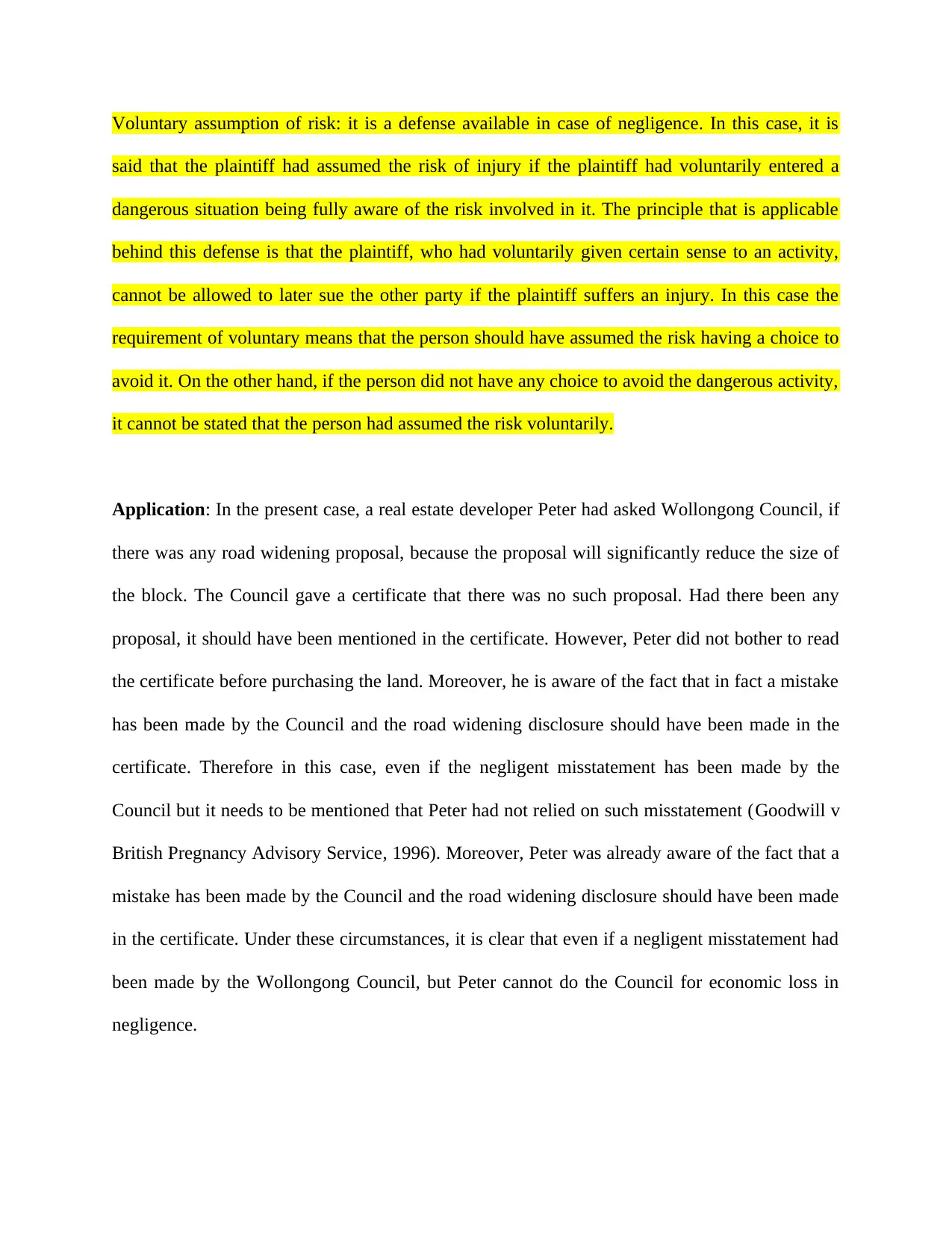
Voluntary assumption of risk: it is a defense available in case of negligence. In this case, it is
said that the plaintiff had assumed the risk of injury if the plaintiff had voluntarily entered a
dangerous situation being fully aware of the risk involved in it. The principle that is applicable
behind this defense is that the plaintiff, who had voluntarily given certain sense to an activity,
cannot be allowed to later sue the other party if the plaintiff suffers an injury. In this case the
requirement of voluntary means that the person should have assumed the risk having a choice to
avoid it. On the other hand, if the person did not have any choice to avoid the dangerous activity,
it cannot be stated that the person had assumed the risk voluntarily.
Application: In the present case, a real estate developer Peter had asked Wollongong Council, if
there was any road widening proposal, because the proposal will significantly reduce the size of
the block. The Council gave a certificate that there was no such proposal. Had there been any
proposal, it should have been mentioned in the certificate. However, Peter did not bother to read
the certificate before purchasing the land. Moreover, he is aware of the fact that in fact a mistake
has been made by the Council and the road widening disclosure should have been made in the
certificate. Therefore in this case, even if the negligent misstatement has been made by the
Council but it needs to be mentioned that Peter had not relied on such misstatement (Goodwill v
British Pregnancy Advisory Service, 1996). Moreover, Peter was already aware of the fact that a
mistake has been made by the Council and the road widening disclosure should have been made
in the certificate. Under these circumstances, it is clear that even if a negligent misstatement had
been made by the Wollongong Council, but Peter cannot do the Council for economic loss in
negligence.
said that the plaintiff had assumed the risk of injury if the plaintiff had voluntarily entered a
dangerous situation being fully aware of the risk involved in it. The principle that is applicable
behind this defense is that the plaintiff, who had voluntarily given certain sense to an activity,
cannot be allowed to later sue the other party if the plaintiff suffers an injury. In this case the
requirement of voluntary means that the person should have assumed the risk having a choice to
avoid it. On the other hand, if the person did not have any choice to avoid the dangerous activity,
it cannot be stated that the person had assumed the risk voluntarily.
Application: In the present case, a real estate developer Peter had asked Wollongong Council, if
there was any road widening proposal, because the proposal will significantly reduce the size of
the block. The Council gave a certificate that there was no such proposal. Had there been any
proposal, it should have been mentioned in the certificate. However, Peter did not bother to read
the certificate before purchasing the land. Moreover, he is aware of the fact that in fact a mistake
has been made by the Council and the road widening disclosure should have been made in the
certificate. Therefore in this case, even if the negligent misstatement has been made by the
Council but it needs to be mentioned that Peter had not relied on such misstatement (Goodwill v
British Pregnancy Advisory Service, 1996). Moreover, Peter was already aware of the fact that a
mistake has been made by the Council and the road widening disclosure should have been made
in the certificate. Under these circumstances, it is clear that even if a negligent misstatement had
been made by the Wollongong Council, but Peter cannot do the Council for economic loss in
negligence.
Paraphrase This Document
Need a fresh take? Get an instant paraphrase of this document with our AI Paraphraser

Conclusion: in the present case, Peter cannot sue Wollongong Council for economic loss
suffered by because in this case, we have not relied on the negligent misstatement and moreover
he was aware of the fact that this statement has been made negligently.
suffered by because in this case, we have not relied on the negligent misstatement and moreover
he was aware of the fact that this statement has been made negligently.
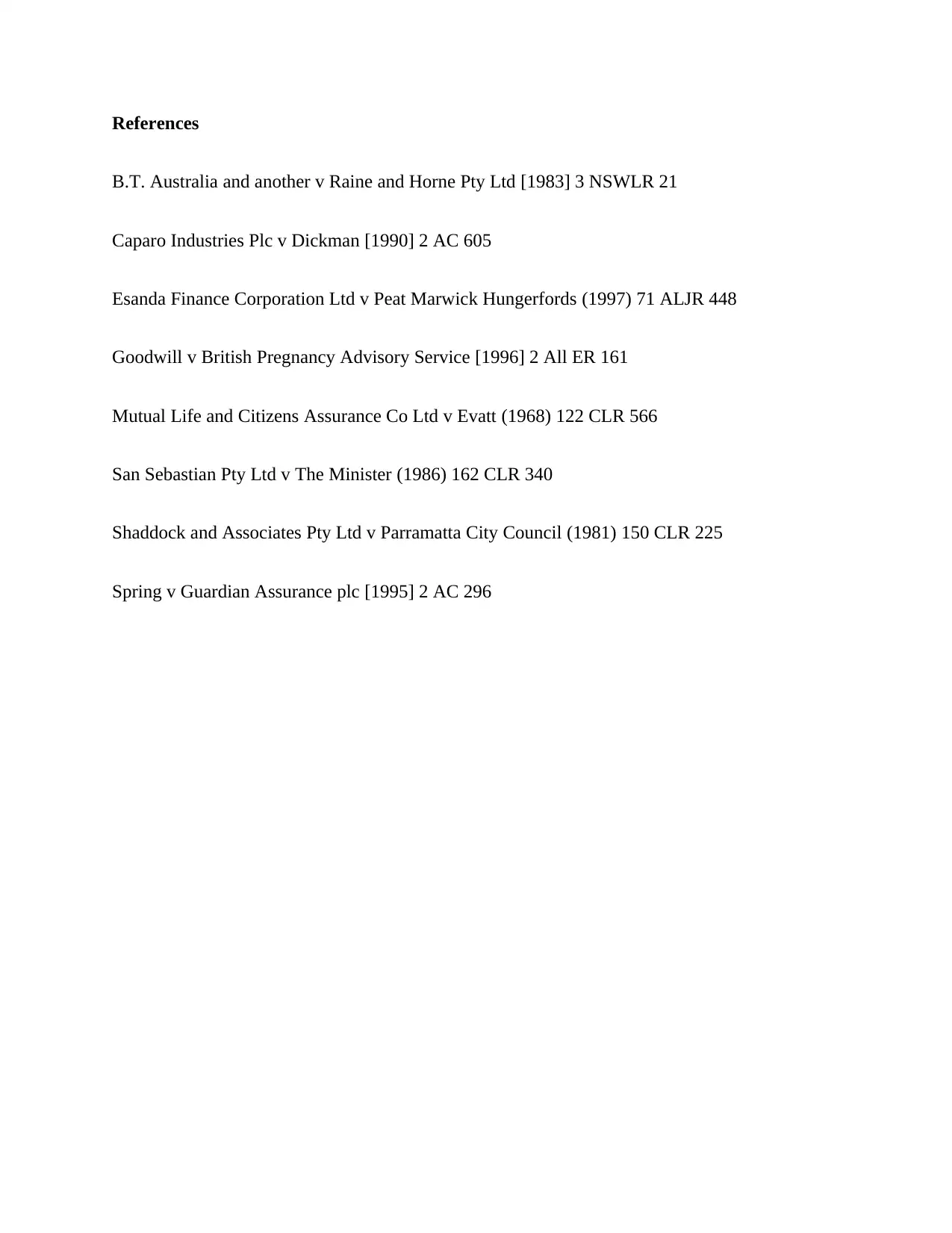
References
B.T. Australia and another v Raine and Horne Pty Ltd [1983] 3 NSWLR 21
Caparo Industries Plc v Dickman [1990] 2 AC 605
Esanda Finance Corporation Ltd v Peat Marwick Hungerfords (1997) 71 ALJR 448
Goodwill v British Pregnancy Advisory Service [1996] 2 All ER 161
Mutual Life and Citizens Assurance Co Ltd v Evatt (1968) 122 CLR 566
San Sebastian Pty Ltd v The Minister (1986) 162 CLR 340
Shaddock and Associates Pty Ltd v Parramatta City Council (1981) 150 CLR 225
Spring v Guardian Assurance plc [1995] 2 AC 296
B.T. Australia and another v Raine and Horne Pty Ltd [1983] 3 NSWLR 21
Caparo Industries Plc v Dickman [1990] 2 AC 605
Esanda Finance Corporation Ltd v Peat Marwick Hungerfords (1997) 71 ALJR 448
Goodwill v British Pregnancy Advisory Service [1996] 2 All ER 161
Mutual Life and Citizens Assurance Co Ltd v Evatt (1968) 122 CLR 566
San Sebastian Pty Ltd v The Minister (1986) 162 CLR 340
Shaddock and Associates Pty Ltd v Parramatta City Council (1981) 150 CLR 225
Spring v Guardian Assurance plc [1995] 2 AC 296
⊘ This is a preview!⊘
Do you want full access?
Subscribe today to unlock all pages.

Trusted by 1+ million students worldwide
1 out of 6
Related Documents
Your All-in-One AI-Powered Toolkit for Academic Success.
+13062052269
info@desklib.com
Available 24*7 on WhatsApp / Email
![[object Object]](/_next/static/media/star-bottom.7253800d.svg)
Unlock your academic potential
Copyright © 2020–2025 A2Z Services. All Rights Reserved. Developed and managed by ZUCOL.




